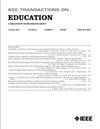学生对基于项目的 Scrum 变体课程中的适应性和工作量与人工制品的看法
IF 2.1
2区 工程技术
Q2 EDUCATION, SCIENTIFIC DISCIPLINES
引用次数: 0
摘要
贡献:报告学生对准备冲刺和虚拟会议的使用,以及在 Scrum 变体项目式课程中结合编码工件的工作量的看法。背景:软件工程(SE)课程在很大程度上采用了 Scrum。文献中对相关方面进行了研究,如教师和学生的整体课程体验、将 Scrum 应用于课堂的挑战以及特定角色的培训。预期成果:设计一门课程,使学生能够接触到在公司环境下使用 Scrum 进行的行业开发项目。主要目的是记录学生在这种情况下的各方面经验(例如,团队框架下的工作量视图),这与使用客观数据(即开发工件)一起,有助于更好地了解学生。应用设计:借鉴以往的教学经验,在基于项目的 SE 课程中设计了 Scrum 变体,考察学生对以下方面的看法:课堂上的 Scrum 适应、团队中的工作量。此外,还调查了这些方面与学生实际开发工作的对比情况。调查结果:通过对数据进行定量分析,连续两年(2020 年和 2021 年)的课程教学结果表明,学生需要一些时间才能提高工作效率并正确估算用户故事,但他们知道自己在团队中的开发工作量。本文章由计算机程序翻译,如有差异,请以英文原文为准。
Students’ Perceptions on Adaptations and Workload Versus Artifacts in a Project-Based Scrum-Variant Course
Contribution: Reporting of students’ view on the use of preparatory sprint and virtual meetings, as well as on the workload effort in combination with coding artifacts in a Scrum-variant project-based course. Background: Scrum has been adopted to a large extent in Software Engineering (SE) courses. Relevant aspects have been examined in the literature, such as the overall course experience from the side of the instructors and the students, the challenges of adapting Scrum for the classroom and training on specific roles. Intended Outcomes: To design a course that allows students to come in contact with developing projects from the industry as would be performed in a company context using Scrum. The main aim was to document aspects of the students’ experience in this context (e.g., workload view in the framework of the team), which—together with the use of objective data, i.e., development artifacts—can assist in understanding students better. Application Design: Drawing upon the previous teaching experience, a Scrum-variant in a project-based SE course was designed, examining how students perceive it in relation to the following aspects: Scrum adaptations in the classroom, workload in the team. How these compare with the actual development work performed by students is also investigated. Findings: The results from two consecutive years of teaching the course (2020 and 2021), applying quantitative analysis on the data, show that students need some time to become productive and estimate user stories correctly but are aware of their development effort within the team.
求助全文
通过发布文献求助,成功后即可免费获取论文全文。
去求助
来源期刊

IEEE Transactions on Education
工程技术-工程:电子与电气
CiteScore
5.80
自引率
7.70%
发文量
90
审稿时长
1 months
期刊介绍:
The IEEE Transactions on Education (ToE) publishes significant and original scholarly contributions to education in electrical and electronics engineering, computer engineering, computer science, and other fields within the scope of interest of IEEE. Contributions must address discovery, integration, and/or application of knowledge in education in these fields. Articles must support contributions and assertions with compelling evidence and provide explicit, transparent descriptions of the processes through which the evidence is collected, analyzed, and interpreted. While characteristics of compelling evidence cannot be described to address every conceivable situation, generally assessment of the work being reported must go beyond student self-report and attitudinal data.
 求助内容:
求助内容: 应助结果提醒方式:
应助结果提醒方式:


